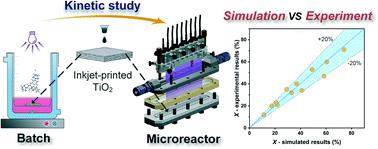当前位置:
X-MOL 学术
›
React. Chem. Eng.
›
论文详情
Our official English website, www.x-mol.net, welcomes your
feedback! (Note: you will need to create a separate account there.)
Investigation of the reaction kinetics of photocatalytic pollutant degradation under defined conditions with inkjet-printed TiO2 films – from batch to a novel continuous-flow microreactor
Reaction Chemistry & Engineering ( IF 3.4 ) Pub Date : 2020-08-11 , DOI: 10.1039/d0re00238k Xiang Zhan 1, 2, 3, 4 , Chenhui Yan 1, 2, 3, 4 , Yilin Zhang 1, 2, 3, 4 , Günter Rinke 1, 2, 3, 4 , Georg Rabsch 1, 2, 3, 4 , Michael Klumpp 1, 2, 3, 4, 5 , Andrea Iris Schäfer 2, 3, 4, 6 , Roland Dittmeyer 1, 2, 3, 4, 5
Reaction Chemistry & Engineering ( IF 3.4 ) Pub Date : 2020-08-11 , DOI: 10.1039/d0re00238k Xiang Zhan 1, 2, 3, 4 , Chenhui Yan 1, 2, 3, 4 , Yilin Zhang 1, 2, 3, 4 , Günter Rinke 1, 2, 3, 4 , Georg Rabsch 1, 2, 3, 4 , Michael Klumpp 1, 2, 3, 4, 5 , Andrea Iris Schäfer 2, 3, 4, 6 , Roland Dittmeyer 1, 2, 3, 4, 5
Affiliation

|
Pollutants accumulating in natural and drinking water systems can cause severe effects to the environment and living organisms. Photocatalysis is a promising option to degrade such pollutants. When immobilizing the photocatalyst, additional catalyst separation steps can be avoided. Among various reactor types, the use of microreactors in photocatalysis has proven advantageous regarding process intensification. However, so far the local conditions are not well understood and described in literature and there is little quantitative understanding of the relevant phenomena. In this work, inkjet-printing was used to immobilize TiO2 as a thin film with a precisely tuneable thickness and catalyst loading. In a batch reactor, the degradation of rhodamine B (RhB) as a model pollutant was performed for different initial concentrations and catalyst layer thicknesses. By employing the Langmuir–Hinshelwood model and a light irradiation model, the kinetic parameters were determined. The influence of the light intensity at different positions inside the immobilized photocatalyst on the reaction kinetics is quantified. RhB degradation was tested under defined operational conditions using an in-house developed continuous-flow microreactor with advanced fiber optics for precise light introduction. The models derived from batch experiments were used to simulate the degradation in the continuous-flow microreactor. Results show that the simulation allows prediction of the performance with less than 20% deviation to the experimental data. An analysis of mass transport effects on the reaction rate indicates that external mass transfer is a limiting factor in the microreactor experiment. This study further demonstrates the potential of the new reactor system (microreactor, fiber optics and printed catalyst) for detailed investigations on photocatalytic reaction kinetics.
中文翻译:

在限定条件下用喷墨印刷的TiO2薄膜对光催化污染物降解的反应动力学进行研究-从批处理到新型连续流微反应器
天然和饮用水系统中积累的污染物可能对环境和生物造成严重影响。光催化是降解此类污染物的有前途的选择。当固定光催化剂时,可以避免额外的催化剂分离步骤。在各种反应器类型中,已证明在光催化中使用微反应器在工艺强化方面是有利的。但是,到目前为止,当地条件还没有在文献中得到很好的理解和描述,并且对相关现象的定量了解也很少。在这项工作中,喷墨印刷用于固定TiO 2作为具有可精确调节的厚度和催化剂负载的薄膜。在间歇式反应器中,针对不同的初始浓度和催化剂层厚度,对作为模型污染物的罗丹明B(RhB)进行了降解。通过使用Langmuir-Hinshelwood模型和光照射模型,确定了动力学参数。定量了固定化光催化剂内部不同位置的光强度对反应动力学的影响。使用内部开发的带有先进光纤的连续流微反应器在确定的操作条件下测试RhB降解,以精确引入光。批处理实验衍生的模型用于模拟连续流微反应器中的降解。结果表明,仿真可以预测性能,并且与实验数据的偏差小于20%。传质对反应速率的影响分析表明,外部传质是微反应器实验中的限制因素。这项研究进一步证明了新的反应器系统(微反应器,光纤和印刷催化剂)在光催化反应动力学方面进行详细研究的潜力。
更新日期:2020-08-25
中文翻译:

在限定条件下用喷墨印刷的TiO2薄膜对光催化污染物降解的反应动力学进行研究-从批处理到新型连续流微反应器
天然和饮用水系统中积累的污染物可能对环境和生物造成严重影响。光催化是降解此类污染物的有前途的选择。当固定光催化剂时,可以避免额外的催化剂分离步骤。在各种反应器类型中,已证明在光催化中使用微反应器在工艺强化方面是有利的。但是,到目前为止,当地条件还没有在文献中得到很好的理解和描述,并且对相关现象的定量了解也很少。在这项工作中,喷墨印刷用于固定TiO 2作为具有可精确调节的厚度和催化剂负载的薄膜。在间歇式反应器中,针对不同的初始浓度和催化剂层厚度,对作为模型污染物的罗丹明B(RhB)进行了降解。通过使用Langmuir-Hinshelwood模型和光照射模型,确定了动力学参数。定量了固定化光催化剂内部不同位置的光强度对反应动力学的影响。使用内部开发的带有先进光纤的连续流微反应器在确定的操作条件下测试RhB降解,以精确引入光。批处理实验衍生的模型用于模拟连续流微反应器中的降解。结果表明,仿真可以预测性能,并且与实验数据的偏差小于20%。传质对反应速率的影响分析表明,外部传质是微反应器实验中的限制因素。这项研究进一步证明了新的反应器系统(微反应器,光纤和印刷催化剂)在光催化反应动力学方面进行详细研究的潜力。











































 京公网安备 11010802027423号
京公网安备 11010802027423号